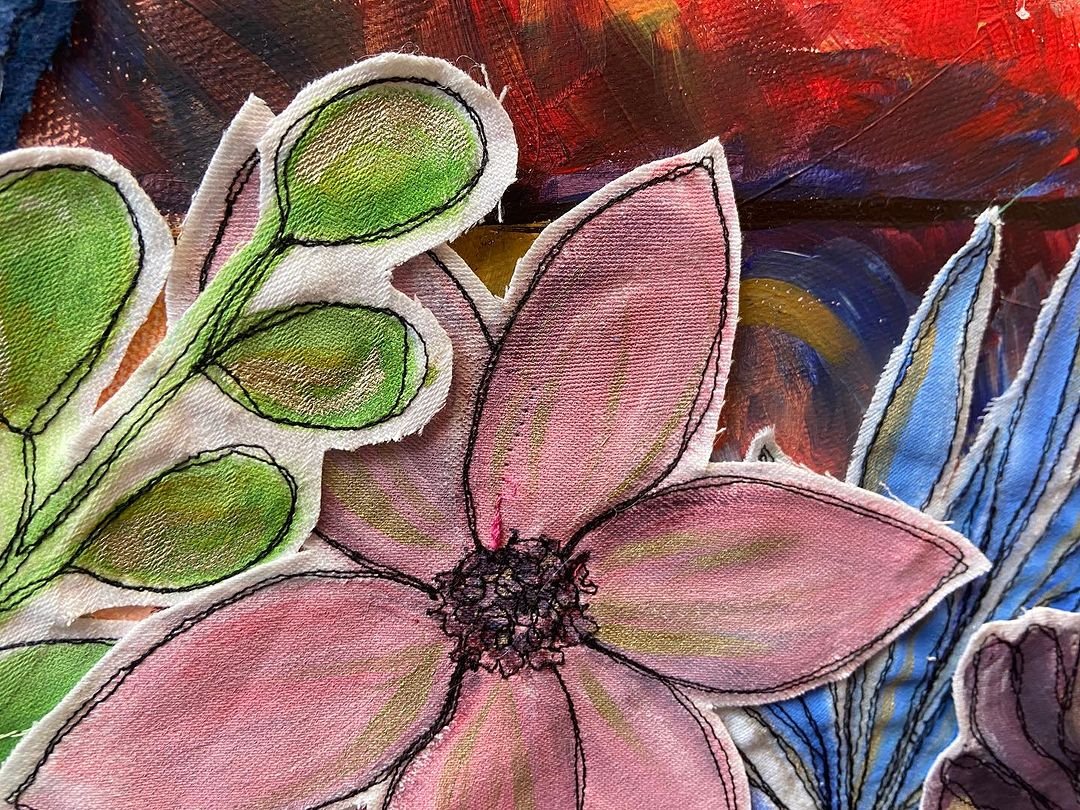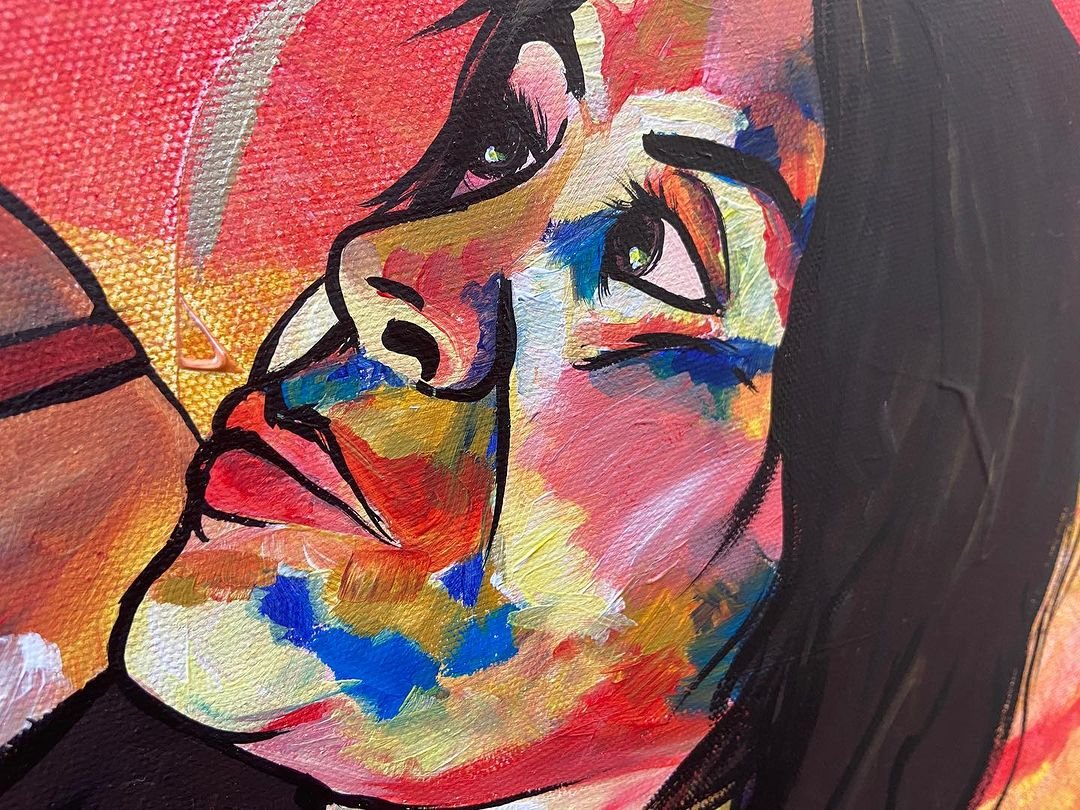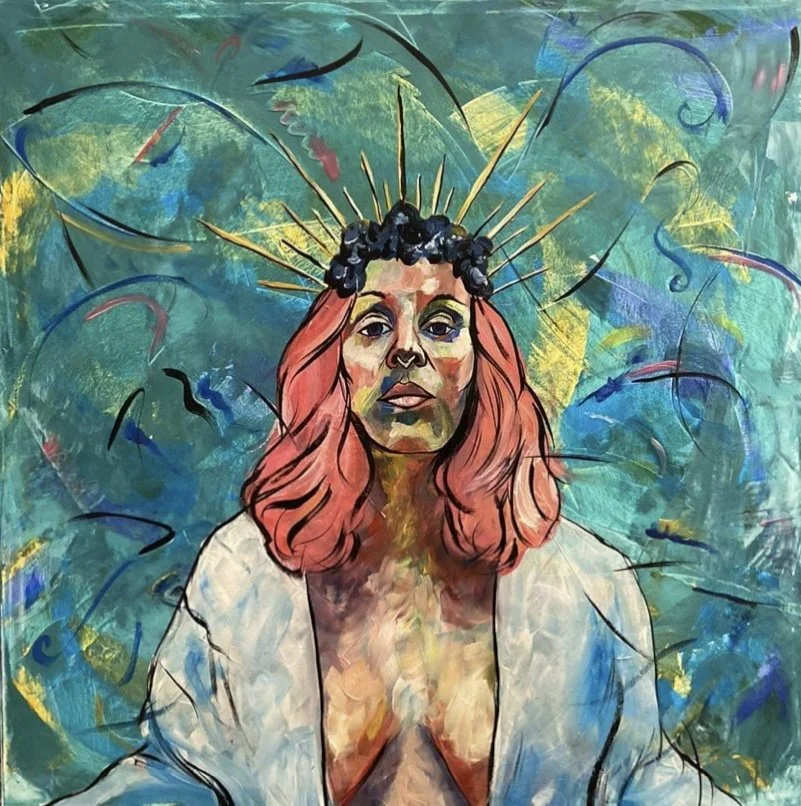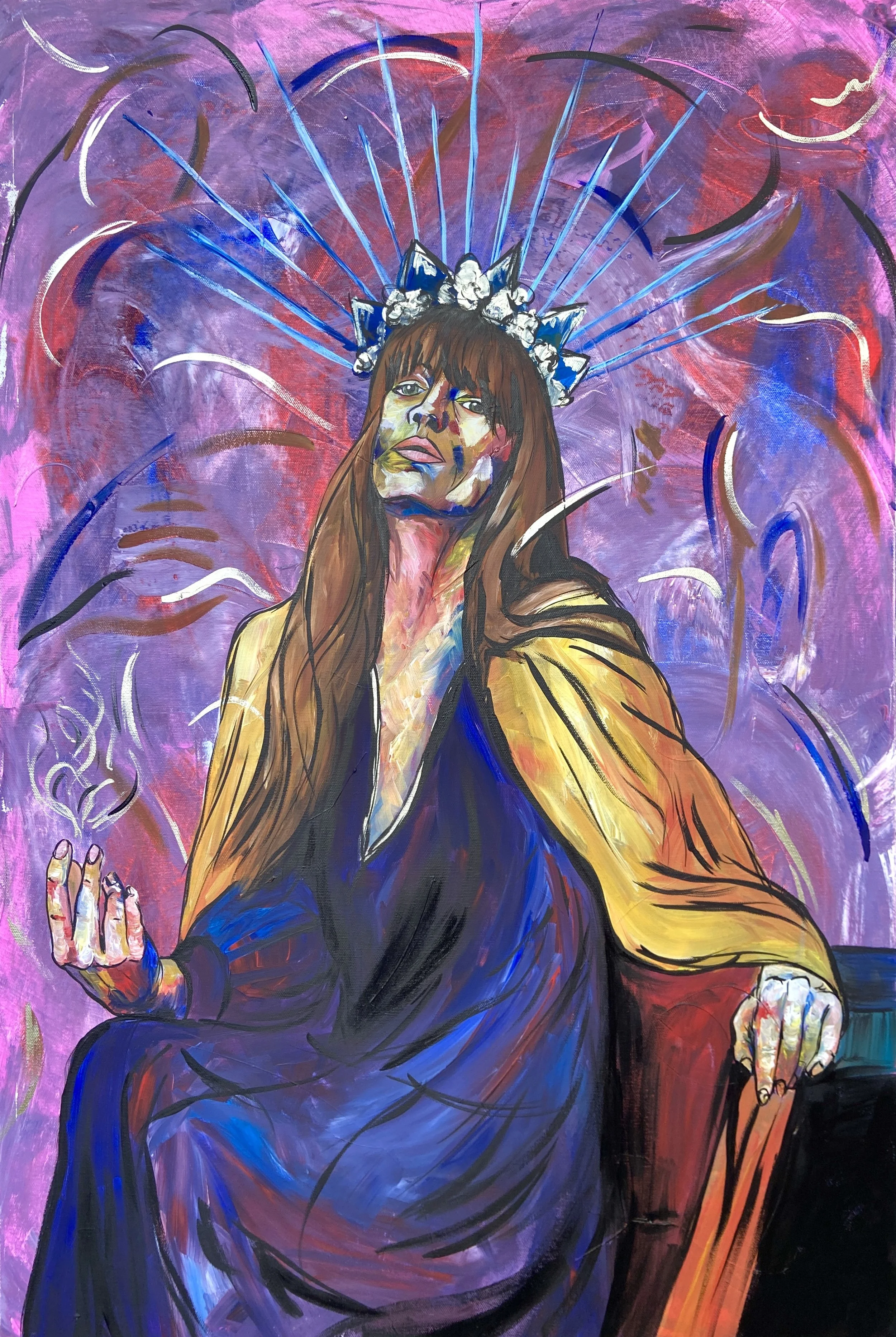Artist in conversation: Harriet Mee
“At the moment, I am very much in the ‘empire building’ phase”
Harriet Mee is a passionate, self-taught painter, muralist and calligrapher based in Stockton-on-Tees in the North East of England. She is currently exploring her unique style through expressionist works and large-scale murals, guided by the mentorship of experienced peers and inspired by the likes of Francis Bacon and Oskar Kokoschka. Her work is vibrant with bright colours and bold outlines.
She enjoys delving into the realm of colour and understanding how different colours can convey various emotions in her artwork. She typically uses non-representational colours in her expressionist portraits and has recently been exploring the themes of motherhood and the childfree by choice community. Currently, she is moving her work into more mixed media works, incorporating free motion embroidery and textiles into her figurative works. She is exploring her own personal experiences around feminism, in particular our culture's attitudes to women’s bodies and diet culture.
With an ambitious plan to travel and meet creative minds, Harriet is on a mission to take their artistry to new heights, build a flourishing business, and create a sustainable arts and culture economy in the Northern UK through establishing a hybrid gallery and artist support institute.
| Instagram |
What initially inspired you to become an artist, and how did you develop your unique style?
I always wanted to be an artist for as long as I can remember. My route into an artist career has been non-traditional in that I have no formal arts education and am completely self-taught. However, I am finding that at least half of the other artists I meet have the same beginnings as me. I couldn’t bear being in my job any longer and had to quit, take the leap, and commit to my art full time. I have always been an artist, and now I have the freedom to make art.
I am still finding my way with my style, but generally I am drawn to create expressionist, bright artworks incorporating non-representational colours to my portraits. I love to work on large canvases and am also developing my skills as a mural artist under the mentorship of more experienced peers here in the North East. The artists’ works I am most inspired by are the works of Francis Bacon and Oskar Kokoschka. I love to explore colour and how colours can communicate emotion in my works.
In terms of subject matter, what themes or motifs do you frequently explore in your work, and what draws you to these topics?
My most recent works have been developed around the theme of my own sense of self. I have been exploring how my own choices to be child-free have impacted my life and created a wholeness with my own inner child. I have taken inspiration from musicians and literature working around the same themes and seek to challenge the idea that only as mothers can women truly reach this ‘goddess’ status we see reflected in popular culture through images such as maternity photography. I hope to create art that speaks to women like me and hold a space for those who may feel unheard in other areas of their lives.
Currently, I am moving my work into more mixed media works, incorporating free motion embroidery and textiles into my figurative works. I am exploring my own personal experiences around feminism, in particular our cultures attitudes to women’s bodies and diet culture.
How do you navigate the balance between self-destruction and re-creation as a way towards conscious Happiness?
I don’t generally do anything self-destructive these days and pretty much have the best job in the world. It doesn’t even feel like work 90% of the time. Not like my job as a teacher did anyway. It took me about two years to establish a stable income from my art, which is where most of my initial stressors came from. But now I have a profitable business and that’s really been down to seeking joy in everything I do. I only accept work these days that I know will make me happy and help build towards my ultimate goals for my artistic life.
Can you discuss a specific piece or project that challenged you as an artist, and how you overcome those challenges?
Early in 2023, I had somewhat lost my way with my personal artworks. I had plenty of commissioned works which were paying the bills but my own passion projects had fallen away. I consider myself to be equal parts entrepreneur and artist, both aspects of my working life providing the fire I need to thrive in an art career. However, I tend towards using business tasks as a procrastination from my art. I did a lot of work on myself and creating an environment, both externally and internally, where my creative practice could flourish. The greatest breakthrough to overcoming this challenge was in discovering residency programs for artists. Lacking confidence to enter a competitive residency, I embarked on my own self-led week away from everything with only my paints and my dog for company. In this week, with the solitude I was so desperately craving, I completed 6 new pieces of artwork in the same number of days. I immediately came home and booked another one at a gallery in Redcar for May 2024 and have committed to completing at least 2 residencies a year.
How do you stay connected with other artists and keep up with new developments and trends in the art world?
I have a built a up a group of artist peers here in the North East who I work with on various projects. I have set up the ‘Harriet Mee Artist Collective’ for when we apply for joint funded ventures and work together professionally. I am a keen networker, this being one of my main strengths in business, and have established connections round Teesside and the wider North East area. I have a CIC which was established last year to allow me to support other creatives with mentoring and business skills (www.futurecreativescic.co.uk). This year, I am project manager for Stockton-on-Tees’ first visual art festival taking place in summer 2024, and will be bringing together as many talented artists from the local area as I can in one weekend. As for trends in the art world, I rely mostly on podcasts, social media and our local exhibitions. I am starting to venture further afield this year and have planned trips to various art fairs around the country to broaden my knowledge of the wider art world. I am a voracious reader in my spare time and love to delve into books about art, galleries and the economics of visual art.
How do you incorporate feedback from critics and audiences into your artistic practice, and how do you balance this feedback with your own artistic intuition?
When I first started out as a full-time artist, I was chasing the money and that resulted in me obsessing over what people would like, so that’s the art that I made. It took a while and lot of soul searching, but ultimately, I just create art that I like. If people also like it and want to buy it, great! If not, no problem. People who have critiqued my work from an artistic point of view always see something in my art that I never intended to put into the painting. I think that is inevitable though and totally out of my control. The only way I use other people’s feedback as a compass for my own artistic intuition, is to create what I hope (because I can’t really know for sure!) will speak to certain people. For example, my most recent series of paintings and accompanying poetry on my experiences of being child-free by choice. This art is primarily for me, to express my own world views and feelings, but I hope that it will also speak to other women in a similar position because it was heavily influenced by music, blogs, Instagram posts and books on the subject.
How do you stay motivated and inspired despite any setbacks or creative blocks you may encounter?
I have developed a few strategies for this over the last year that have now become my normal routine. With these foundations, I pretty much maintain a drive of creativity and motivation (unless I get really tired, then I have to rest!):
SLEEP! I have a very rigid sleep pattern and get at least 7 hours every night.
I have a studio in the town centre so I have separation between my home life and art/business life.
As I mentioned before, I try to avoid doing anything that doesn’t bring me joy or serve my larger artistic goals.
I journal almost every day. I know it is an oldie but I recently went through Julia Cameron’s ‘The Artist’s Way’ 12 week program and I haven’t stopped journaling since. I don’t actually use a sketchbook to draft ideas for my work, I prefer to write about it instead then go straight to the final piece when I have figured it out through writing.
I have a support network of other artists who I talk to regularly about their projects and I can talk about mine. If I am struggling, I can reach out and find inspiration or solutions.
I do lots of creative and repetitive crafty things at home which I find really meditative, such as crochet and cross stich. I get all my best ideas while crocheting!
I keep it diverse in terms of my skills and artistic interests. I am always on the look out for people to mentor me in new disciplines and short courses to attend. At the moment, I am learning how to create stained glass works and have recently completed a free motion embroidery course. I am working with a spray paint artist in Durham who is mentoring me in how to create huge outdoor mural works. I don’t stick to just one thing.
How do you feel about exhibiting your artworks with The Holy Art Gallery?
I feel really excited about this opportunity and also a fulfillment of a goal. I think most artists struggle with imposter syndrome in one way or another, and having my artwork accepted to be displayed in the Holy Art Gallery has really given me a new lease of confidence in my work to overcome these feelings. I am really excited about the prospect of networking with people outside the North East and speaking to other art professionals about my work.
Looking ahead, what are your long-term goals and aspirations as an artist, and how do you plan to achieve them?
That’s a big question! At the moment, I am very much in ‘empire building’ phase. I plan to travel to as many places as I can in the next few years, meet as many interesting, creative people as I can. I want my work to reach new heights (figuratively and literally!) and develop my skills and mural works. I want to build my business to the point where I can take on staff and get a commercial space of my own one day. Probably some sort of hybrid space for a gallery and an artist support institute which contributes to a sustainable arts and culture economy here in the North. I think the festival I’m organising is going to play a big part in establishing my reputation in these areas. I want to develop my talents as a curator and build a bigger collective of artists around Teesside who are as driven as I am. I’d like my work to be recognised nationally and internationally so that eventually clients are commissioning me for my particular style of art.







